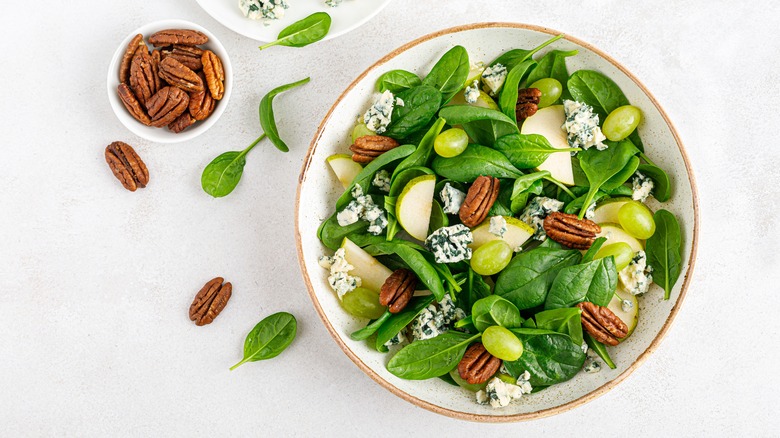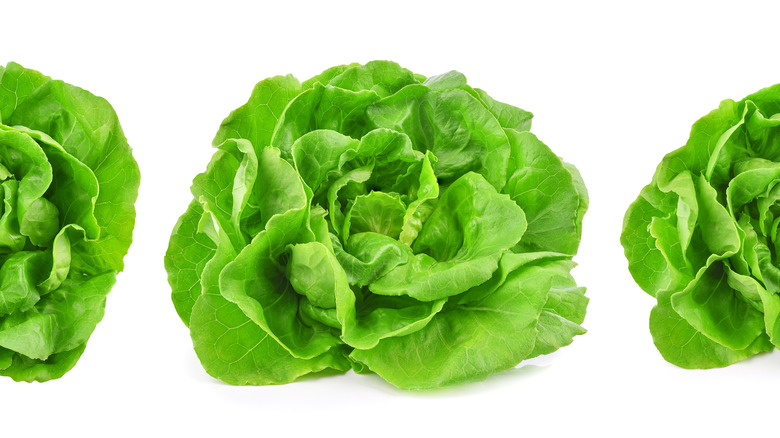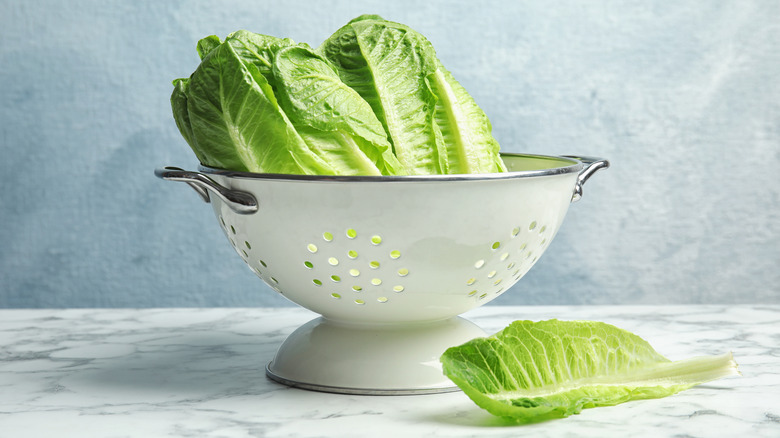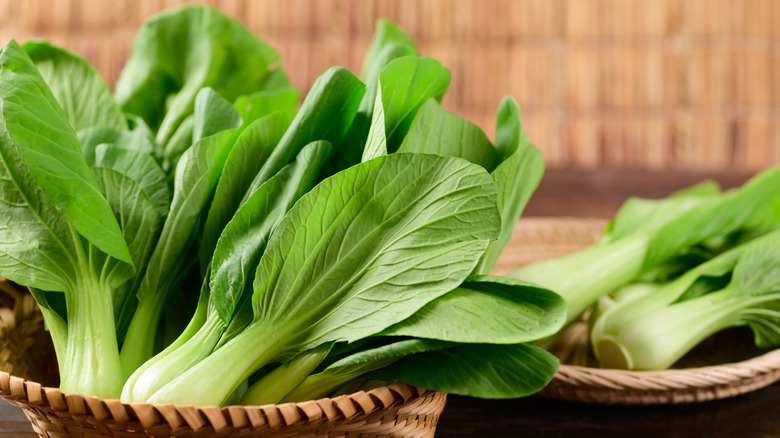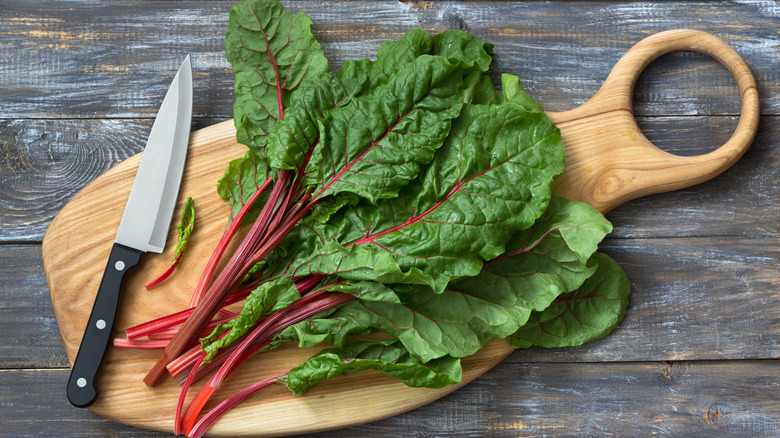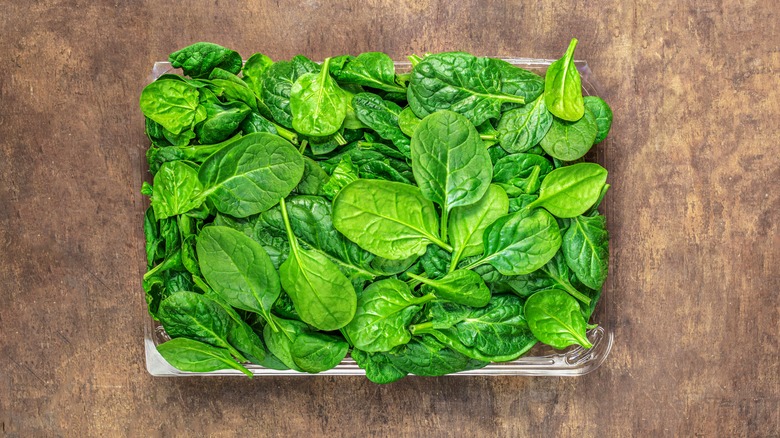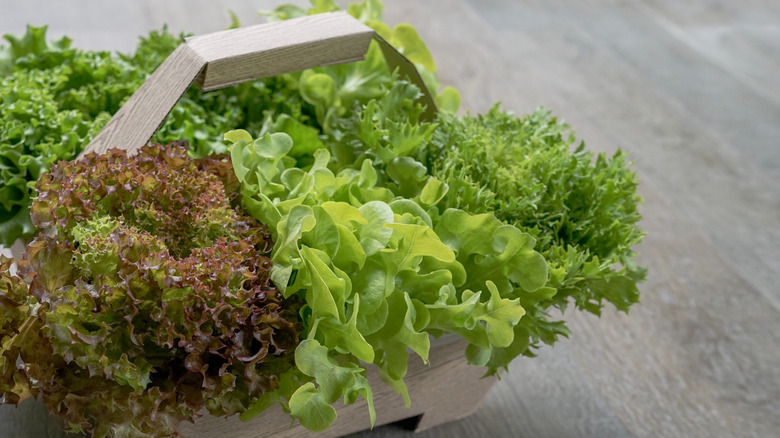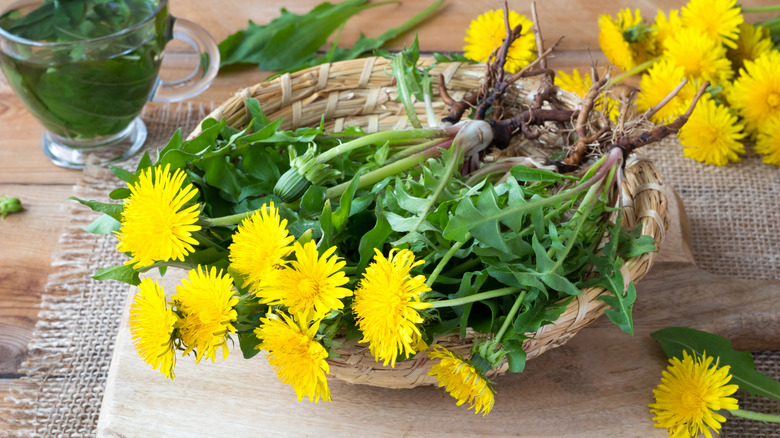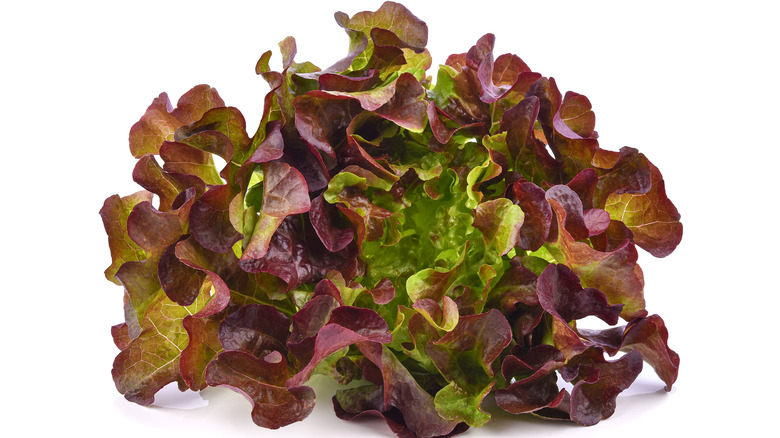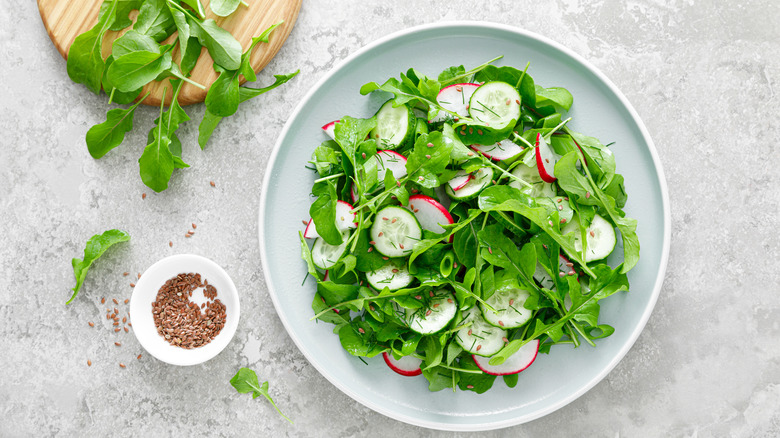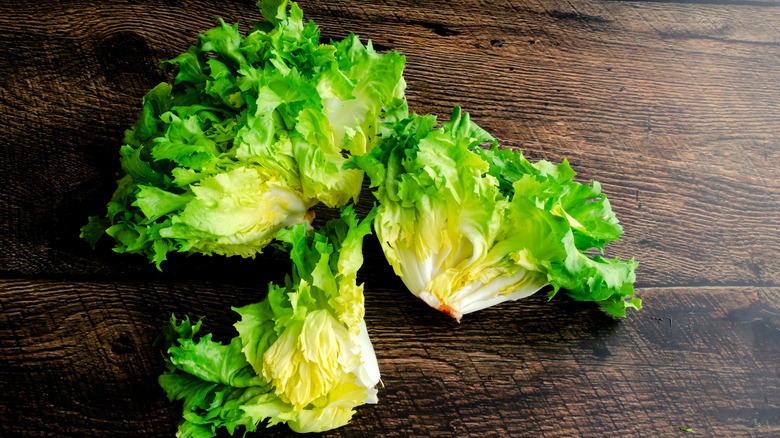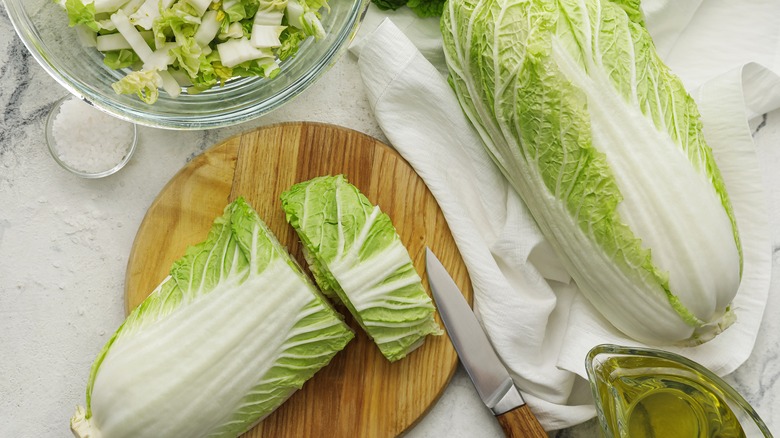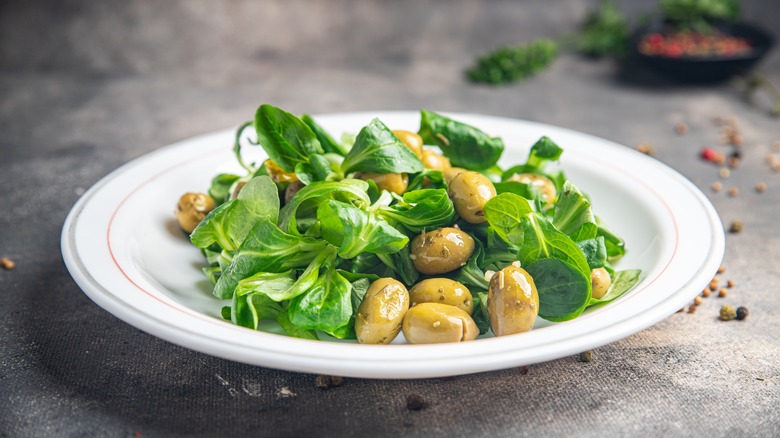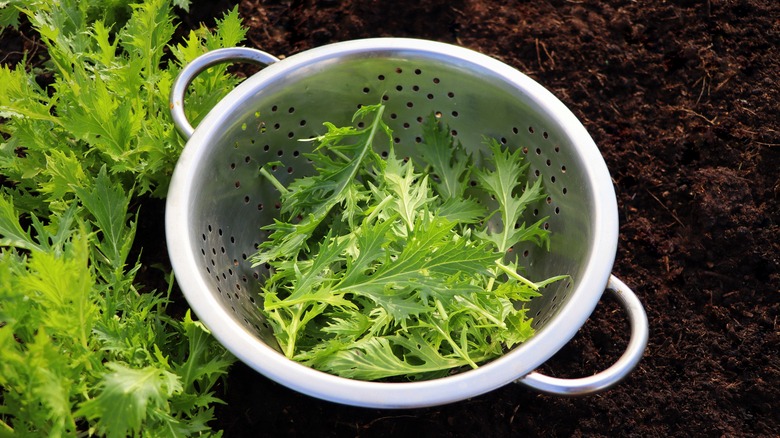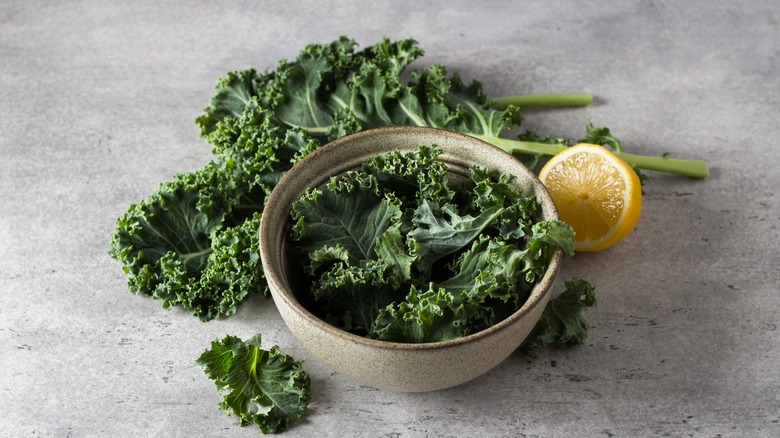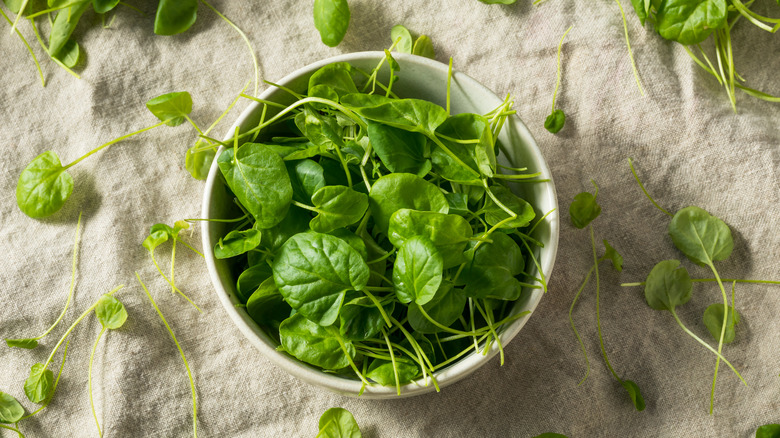15 Types Of Greens That Are Perfect For Salads
There are few food groups as versatile as salads, as hundreds of variations exist. You'll find them with and without greens, cold or hot ones, and even sweet options that all fall under the salad umbrella. When a classic Caesar or Cobb salad doesn't fit your mood, finding another recipe is not difficult. Unfortunately, the endless variety can make it easy for any chef to fall into a rut.
It might seem obvious to experiment when you get stuck, and changing up your ingredients is a great way to spark a new love for salads. By switching from chicken to salmon, or corn to beans, you can create an entirely different flavor profile on top of the same iceberg lettuce you've been using. If you are less interested in changing your regular salad add-ins, try updating the salad's base. Modifying your greens is a great way to inspire creativity and introduce potential health benefits to your diet. Allow us to introduce you to a selection of standard and uncommon greens, perfect for your next salad experience.
Butter lettuce
Butterhead, or butter, lettuce is a popular option for daily salad greens. The leaves are relatively small and tender with a mild, buttery flavor, hence the name. If you think this green looks familiar, you'd be right, as it's prevalent in salads. Butter lettuce also goes by the names Bibb lettuce and Boston lettuce (via Grower Today). All three varietals have small round heads with loose leaves.
According to Healthline, butter lettuce is known as a great source of vitamin K. It also boasts a good amount of folate and vitamin A. With the mild flavor of these leaves, butter lettuce is a green that lends itself well to almost any salad. Add citrus and top with grilled shrimp to create a showstopper summer salad, or reach further into classic recipes and try a delicious salad Niçoise with fresh vegetables, tuna, and a basic vinaigrette.
Romaine
Romaine lettuce is a classic for a reason. It's mild, versatile, and readily available, making it no surprise that it accounts for 30% of all salads (via Colorado State's Food Source Information). Specialty Produce describes romaine as "crisp, succulent, and crunchy," and we couldn't agree more. The produce provider also claims that romaine thrives both when used raw and torn fresh for salads and when cooked by braising or grilling the leaves before it's added to a recipe.
Though we often relegate romaine to the realm of iceberg lettuce, it's much more nutritionally dense than the other salad staple. According to EatingWell, romaine lettuce has roughly the same amount of vitamin A as spinach per serving and is a substantial source of antioxidants. You can skip the Caesar salad and try a sweet mango chicken, or mix chopped romaine with herbs and a pomegranate molasses dressing to create a gorgeous fattoush.
Bok choy
Bok choy, literally "white vegetable" in Cantonese (via Daily Harvest Express), is a member of the Brassica family, along with broccoli, kale, and collard greens. This close family relation also makes bok choy an excellent source of nutrients. According to Healthline, bok choy is a fantastic source of vitamins C and K. This cruciferous vegetable also acts as a source of fiber, another essential element to keeping healthy.
There are two varietals of bok choy, baby and regular. Vanjo Merano from Panlasang Pinoy explains that these two types really only differ in size. Baby bok choy matures in 40 days, whereas regular bok choy takes 10 more days to grow. The younger leaves of baby bok choy are milder and more tender, making them ideal for raw salads. If you prefer to cook your bok choy, it holds up well to grilling and sautéing. Try adding stir-fried bok choy to your next salad for a hint of the green's mustard flavor.
Chard
While kale is cemented in the culinary world, it can still be daunting to work with, especially if you're not a fan of the notoriously bitter flavor. Enter chard — kale's milder cousin with similar nutrition benefits. A 300-gram serving of raw chard contains more magnesium and iron than kale, though kale outperforms chard in calcium, copper, and potassium (per Foodstruct). Chard is especially good for those on a low-carb, low-sugar, or low-calorie diet, as it outperforms kale in all of those areas.
Despite chard's milder taste, it can still present a few challenges in the kitchen. Luckily, it can be prepared in the same way as kale by taking a moment and massaging the leaves before using them raw. If you prefer to cook your dark leafy greens, you're in luck. Contrary to most kale recipes that call for removing the ribs, chard ribs are edible and provide a great pop of color in your next warm salad.
Spinach
Spinach is an excellent source of iron and vitamin K1 (via Healthline). Its tender leaves and mild, sweet flavor lends themselves well to almost every application. Enjoy spinach raw and paired with something acidic like grapefruit to bring out its natural sweetness, or sauté it with mushrooms and aromatics like garlic, onion, or shallots before adding it to a salad. Though spinach is a common salad ingredient for most and can become a little boring, it's a great base for most toppings. Spinach is also perfect for experimentation, like a cold soba noodle salad with miso and spicy tahini.
Unfortunately, spinach is one of those greens that seem to spoil the day after you buy it. Spinach will stay fresh for a few hours if it's kept out of direct sunlight. For the best results, keep fresh spinach in the fridge and avoid washing the leaves until right before you plan to use them.
Frisée
Also known as curly endive, frisée lettuce is a great variant to add a unique texture or appearance to your salads. According to Saladpedia, the outer leaves have a deeper, more bitter flavor, though the lighter internal leaves of the lettuce are bright and somewhat tart. This makes it particularly great for bistro salads with fatty toppings like bacon and blue cheese or as a topping for salads that contain sweeter elements like grapes or buttery cheeses such as brie or soft goat cheese.
Like all endives, frisée is a member of the chicory family and can be used in the same ways (via MasterClass). Frisée lettuce benefits from tearing rather than chopping the leaves into pieces, as it keeps you away from the pale white core, which is notoriously bitter. Frisée pairs beautifully with chicken, and exploring the world of hot salads with a warm chicken salad on greens rather than a traditional mayonnaise-based chicken salad can bring more exciting flavors and experiences to the table.
Dandelion greens
Though we don't recommend eating weeds directly from your local park without an in-depth knowledge of the potential pesticides used, dandelion greens are an amazing salad option for those who are adventurous enough to try them. Versatile and peppery, these greens are great as a base for salads or mixed in with other types of lettuce and herbs. They can be eaten raw, braised, and sautéed with garlic and Parmesan to make a great topper for salads; their citrusy taste and peppery bite make them fantastic for pairing with a variety of different flavors.
These simple weeds are dietary powerhouses (via Michigan State University). Dandelions boast large amounts of nutrients and antioxidants, including riboflavin and vitamin A. Just one cup of these greens contain two times the amount of iron as spinach and offers 500% of your daily intake of vitamin K. If you consider adding dandelion greens to your repertoire, try finding young greens at local farmers markets, or grow them yourself and keep them away from any weed killers and pest control.
Red leaf lettuce
If you have ever picked up a lettuce blend from your grocery store of choice, you probably came across green and red leaf lettuce. This type of green is also called loose leaf lettuce and comes in two varietals: green and red. Per Produce Market Guide, red loose leaf lettuce has straight leaves tipped with maroon that tends to frill out on the edges. The leaves also tend to be on the smaller side, averaging between five and six inches, so it's great for chopped salads when you want to use the entire head of lettuce.
The leaves are incredibly tender and have a very mild taste and a decent amount of nutrients like vitamins A and K (via Lettuce Info), which makes them synonymous with salad mixes and act as an excellent base for salads where you want the toppings to be the star of the meal. No matter the color, loose leaf lettuce is a good choice for summer salads and pairs well with other seasonal produce, including berries and grilled corn.
Arugula
Peppery, tender, and delightful, arugula is more than capable of stepping away from lettuce blends to stand on its own. Though it's closely related to broccoli and Brussels sprouts, arugula is known for bringing a mustardy kick to salads. Though Encyclopedia Britannica classifies arugula (or "rocket" in the U.K.) as an herb from the mustard family, it's generally consumed as a vegetable and used in the same ways. This leafy green is rich in vitamins A, C, and K, as well as iron, calcium, and folic acid.
Foodiosity clarifies that arugula is similar to dandelion greens and other dark leafy greens, meaning that arugula is milder when it's young, and the peppery taste is less pungent. If you're working with a bitter ingredient or something that would benefit from acidity, arugula is your new best friend. While it is fantastic raw and mixed in with other greens in a salad, it's really the star in this seared wax bean salad that's perfect for using up the last of the beans from the garden.
Escarole
Escarole is another member of the chicory family, making it nutritionally similar to endives and other dark leafy greens like kale. Escarole looks like a cross between butter lettuce and frisée, and it's commonly found in traditional Italian cooking, like the ever-popular Italian wedding soup. When eaten raw, it's slightly bitter, as is typical for most chicory, but escarole is highly versatile and accessible compared to some of the other members of this illustrious family.
Escarole can be braised or sautéed before you add it to a warm salad and is an excellent addition to soups and pasta. Luckily, escarole is easy to find at most specialty grocers or farmers markets. This ease of access makes it an easy alternative when you're tired of kale and want something milder than chard. The slight bitterness of escarole pairs perfectly in salads with sweeter toppings like apples and earthy golden beets, so it's ideal for winter months, as escarole is also in season along with these ingredients.
Napa cabbage
Though it often brings to mind California vineyards, napa cabbage's name actually refers to the Japanese word nappa, which means "leafy green." Cabbage might not be your first thought when it comes to salad greens, but if you turn up your nose at this crunchy, mildly flavored vegetable, you're missing out on an excellent option for your next lunch break. This cabbage differs from its red and standard green relatives in both size and flavor. It's both sweeter and milder than regular cabbage, which makes it ideal for eating raw.
Shred napa cabbage into a slaw-like salad, or use the tender interior leaves as the base of any salad that uses romaine. This mild green thrives in salads with salty dressings based on soy sauce and sesame oil or as a carrier for spice and acid to cut through fatty foods like bulgogi or pork belly. Similar to bok choy in terms of nutrition, it's a little less nutritionally dense compared to the darker green leaves of its cousin, but still a delicious and healthy addition to any salad you prefer.
Mȃche
Though the name mȃche might catch you off guard, according to Dutch Meadows Farms, many people have tried this small leafy green or something similar to it before. Mȃche is a cold-weather green that is also known by the names lamb's lettuce and corn salad, and the soft nutty flavor of the leaves lends itself well to that name. It contains a good amount of calcium, copper, and iron in each serving and can provide 64% of the daily recommended value of vitamin C with a 3.5-ounce serving (via Heal with Food).
Similar to spinach, but with less bitterness, mȃche can be used and prepared in many of the same ways. You can steam the leaves for other uses or eat them raw in salad mixes like mesclun and as a complement to sharper or more strongly flavored greens like mustard greens (per Harvest to Table).
Mizuna
Mizuna is by far one of the most interesting potential additions to your salad rotation. It boasts a uniquely sharp flavor profile, serrated feathery edges, and a long history to boot. According to Masterclass, mizuna is considered a "Kyo yasai," or an heirloom crop from Kyoto, Japan. The versatility of this green is nearly unmatched, as it has almost 15 different varieties and is an excellent accompaniment to salads, soups, dumplings, and more (via Umami Insider). According to Ennabta Farms, it's also an excellent source of vitamins A, C, and K and various antioxidants.
If you plan to prowl your local Asian supermarket in search of these beautiful Japanese mustard greens, try stir-frying them in a little olive oil. They'll maintain crunch and flavor while the heat mellows out their spice. These greens highlight the natural sweetness of other vegetables and serve as a showcase for these flavors, like this fresh tomato salad with coriander vinaigrette.
Kale
Kale has been the reigning queen of salad greens ever since its explosion into the culinary scene. For years, it seemed like kale was everywhere, from smoothies to pasta, and thankfully, it's managed to ride the wave of fame with its head held high. Many still consider kale a superfood, with dieticians and home cooks praising its nutritional value. According to the Harvard School of Public Health, kale contains high amounts of vitamins A, K, B6, and C, as well as calcium, potassium, copper, and manganese. Harvard also states that kale and other cruciferous vegetables contain a chemical called glucosinolates that scientists are researching for their potential role in preventing certain cancers and heart diseases.
Beyond its bountiful health benefits, kale is a delicious choice for diversifying your diet. Its dark leaves can be used in a variety of salads, from an avocado and sweet corn Mexican salad to a hearty Greek salad that's made more filling for the winter with cranberries and green apples. Regardless of how you choose to use kale, be it steamed and sautéed or raw and shredded, make sure to avoid common kale mistakes and take a few extra moments during prep to get those fibrous leaves tender enough to enjoy.
Watercress
Watercress, or just "cress" if you're in a hurry, is a member of the Brassicaceae family. It's closely related to vegetables like broccoli, radishes, and arugula. According to The Watercress Company, this green has a long history dating back to ancient Greece. According to legend, the Greek father of medicine, Hippocrates, founded his first hospital close to a stream where watercress was abundant in order to always have access to the plant he used to treat his patients. The Aggregate Nutrient Density Index found that watercress is a fantastic supply of vitamins such as vitamins C, K, and A and that it's a low-calorie and low-sodium green with plenty of health benefits (via B&W Quality Growers.)
Similar to arugula and other greens in the Brassicaceae family, cress is bright and peppery, making it ideal for fresh summer salads or any salad looking for an acidic kick. For example, in a Dungeness crab salad with fennel and roasted red peppers, watercress works in tandem with grapefruit segments to elevate the sweetness of the crabmeat to new heights.
